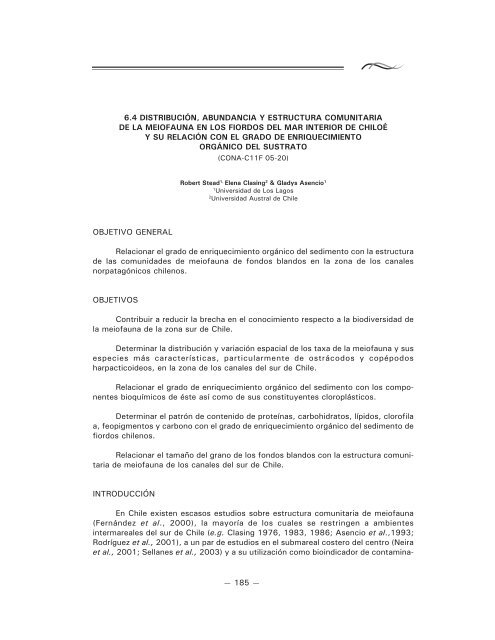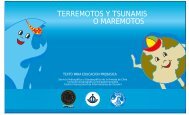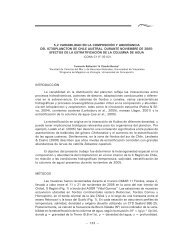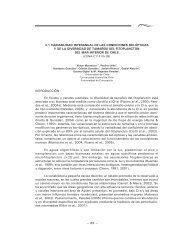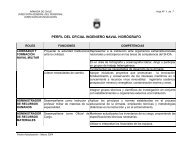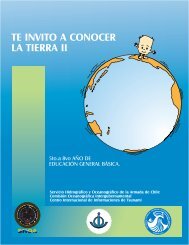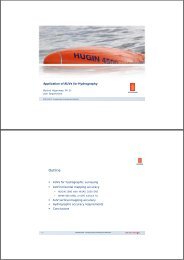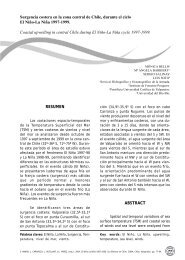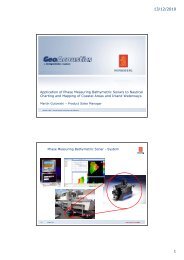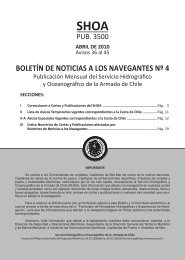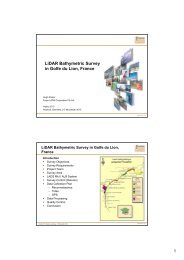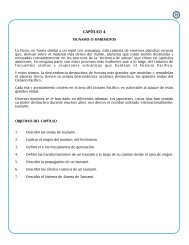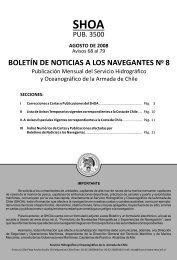Distribución, abundancia y estructura comunitaria de la ... - Shoa
Distribución, abundancia y estructura comunitaria de la ... - Shoa
Distribución, abundancia y estructura comunitaria de la ... - Shoa
Create successful ePaper yourself
Turn your PDF publications into a flip-book with our unique Google optimized e-Paper software.
6.4 DISTRIBUCIÓN, ABUNDANCIA Y ESTRUCTURA COMUNITARIADE LA MEIOFAUNA EN LOS FIORDOS DEL MAR INTERIOR DE CHILOÉY SU RELACIÓN CON EL GRADO DE ENRIQUECIMIENTOORGÁNICO DEL SUSTRATO(CONA-C11F 05-20)Robert Stead 1, Elena C<strong>la</strong>sing 2 & G<strong>la</strong>dys Asencio 11Universidad <strong>de</strong> Los Lagos2Universidad Austral <strong>de</strong> ChileOBJETIVO GENERALRe<strong>la</strong>cionar el grado <strong>de</strong> enriquecimiento orgánico <strong>de</strong>l sedimento con <strong>la</strong> <strong>estructura</strong><strong>de</strong> <strong>la</strong>s comunida<strong>de</strong>s <strong>de</strong> meiofauna <strong>de</strong> fondos b<strong>la</strong>ndos en <strong>la</strong> zona <strong>de</strong> los canalesnorpatagónicos chilenos.OBJETIVOSContribuir a reducir <strong>la</strong> brecha en el conocimiento respecto a <strong>la</strong> biodiversidad <strong>de</strong><strong>la</strong> meiofauna <strong>de</strong> <strong>la</strong> zona sur <strong>de</strong> Chile.Determinar <strong>la</strong> distribución y variación espacial <strong>de</strong> los taxa <strong>de</strong> <strong>la</strong> meiofauna y susespecies más características, particu<strong>la</strong>rmente <strong>de</strong> ostrácodos y copépodosharpacticoi<strong>de</strong>os, en <strong>la</strong> zona <strong>de</strong> los canales <strong>de</strong>l sur <strong>de</strong> Chile.Re<strong>la</strong>cionar el grado <strong>de</strong> enriquecimiento orgánico <strong>de</strong>l sedimento con los componentesbioquímicos <strong>de</strong> éste así como <strong>de</strong> sus constituyentes cloroplásticos.Determinar el patrón <strong>de</strong> contenido <strong>de</strong> proteínas, carbohidratos, lípidos, clorofi<strong>la</strong>a, feopigmentos y carbono con el grado <strong>de</strong> enriquecimiento orgánico <strong>de</strong>l sedimento <strong>de</strong>fiordos chilenos.Re<strong>la</strong>cionar el tamaño <strong>de</strong>l grano <strong>de</strong> los fondos b<strong>la</strong>ndos con <strong>la</strong> <strong>estructura</strong> <strong>comunitaria</strong><strong>de</strong> meiofauna <strong>de</strong> los canales <strong>de</strong>l sur <strong>de</strong> Chile.INTRODUCCIÓNEn Chile existen escasos estudios sobre <strong>estructura</strong> <strong>comunitaria</strong> <strong>de</strong> meiofauna(Fernán<strong>de</strong>z et al., 2000), <strong>la</strong> mayoría <strong>de</strong> los cuales se restringen a ambientesintermareales <strong>de</strong>l sur <strong>de</strong> Chile (e.g. C<strong>la</strong>sing 1976, 1983, 1986; Asencio et al.,1993;Rodríguez et al., 2001), a un par <strong>de</strong> estudios en el submareal costero <strong>de</strong>l centro (Neiraet al., 2001; Sel<strong>la</strong>nes et al., 2003) y a su utilización como bioindicador <strong>de</strong> contamina-— 185 —
Crucero CIMAR 11ción (Larraín et al., 1998; Lee et al., 2001). Así, antes <strong>de</strong> utilizar a <strong>la</strong> meiofauna comobioindicador <strong>de</strong> contaminación orgánica o química, es necesario evaluar <strong>la</strong> <strong>estructura</strong> <strong>de</strong><strong>la</strong>s comunida<strong>de</strong>s <strong>de</strong> fondos b<strong>la</strong>ndos, contrastando sitios <strong>de</strong> simi<strong>la</strong>res características <strong>de</strong>tamaño <strong>de</strong> grano y que presenten diversos grados <strong>de</strong> intervención antrópica, vale <strong>de</strong>cirsitios bajo régimen <strong>de</strong> diversos grados <strong>de</strong> utilización por acuicultura o <strong>de</strong>sarrollo urbano, yáreas <strong>de</strong> menor intervención.El objetivo principal <strong>de</strong> este estudio es evaluar <strong>la</strong> <strong>abundancia</strong>, diversidad y riqueza<strong>de</strong> los diferentes taxa <strong>de</strong> <strong>la</strong> meiofauna en sectores <strong>de</strong> fondos b<strong>la</strong>ndos <strong>de</strong> <strong>la</strong> zonacostera <strong>de</strong>l seno Reloncaví, Golfo <strong>de</strong> Ancud y Golfo Corcovado, así como en losfiordos <strong>de</strong> <strong>la</strong> zona <strong>de</strong> Chiloé continental, comparándolos con variables sedimentarias,como tamaño <strong>de</strong> grano y contenido <strong>de</strong> materia orgánica en sus componentes <strong>de</strong>proteínas, lípidos y carbohidratos, así como <strong>de</strong> pigmentos cloroplásticos. La informaciónobtenida constituirá el primer registro extensivo <strong>de</strong> meiofauna submareal para <strong>la</strong>zona, con <strong>la</strong> cual se evaluará <strong>la</strong> posibilidad <strong>de</strong> que <strong>la</strong> meiofauna pueda constituirse enun bioindicador <strong>de</strong> contaminación orgánica para <strong>la</strong> zona sur <strong>de</strong> Chile.MATERIALES Y MÉTODOSLa segunda etapa <strong>de</strong>l crucero CIMAR 11 Fiordos se realizó entre los días 11 y 21 <strong>de</strong>noviembre <strong>de</strong> 2005 a bordo <strong>de</strong>l AGOR “Vidal Gormaz”. El programa original para esteproyecto contempló <strong>la</strong> toma <strong>de</strong> muestras en 25 estaciones ubicadas en el mar interior <strong>de</strong>Chiloé entre el estero Reloncaví y <strong>la</strong> boca <strong>de</strong>l Guafo, obteniéndose finalmente muestrasen 24 estaciones (18 originalmente contemp<strong>la</strong>das más 6 estaciones adicionales) en cadauna <strong>de</strong> <strong>la</strong>s secciones asignadas al proyecto (Ver Tab<strong>la</strong> 20.1).Las muestras <strong>de</strong> sedimentos fueron tomadas con box core (24,5 x 24,5 x 50,5cm), <strong>de</strong>s<strong>de</strong> el cual se obtuvieron 6 submuestras <strong>de</strong> los 2,5 cm superficiales <strong>de</strong>l sustratomediante mini-core (2,9 cm diámetro) individuales. Éstas fueron <strong>de</strong>stinadas aleatoriamentea muestras <strong>de</strong> fauna y a análisis bioquímicos, pigmentos cloroplásticos y granulometría,respectivamente. Parale<strong>la</strong>mente a <strong>la</strong> toma con box-core, se midió <strong>la</strong> temperatura superficial<strong>de</strong>l sustrato (± 0,1 ºC). En estaciones adicionales, muestras obtenidas por gravitycorer se procesaron <strong>de</strong> manera simi<strong>la</strong>r, mientras que <strong>la</strong>s muestras obtenidas por buceo seobtuvieron directamente con mini-core (2,9 cm <strong>de</strong> diámetro).Las muestras <strong>de</strong> fauna (n=3) fueron colectadas en frascos plásticos <strong>de</strong> 50 ml ypreservados inmediatamente en etanol a 70%. En el <strong>la</strong>boratorio se procedió a teñir<strong>la</strong>s conRosa <strong>de</strong> Benga<strong>la</strong> y a procesar<strong>la</strong>s según Pfannkuche & Thiel, 1988. La fauna procesadafue i<strong>de</strong>ntificada generalmente hasta nivel <strong>de</strong> c<strong>la</strong>se o hasta nivel <strong>de</strong> especie cuando seaposible.Las muestras parale<strong>la</strong>s para análisis bioquímicos y granulométrico (n=3) fueronpuestas en bolsas plásticas individuales, conge<strong>la</strong>das (–70 ºC) y posteriormenteliofilizadas. Para el análisis granulométrico se procesaron <strong>la</strong>s muestras por tamizajehúmedo, según An<strong>de</strong>rson et al. (1983) y los resultados expresados en fracción re<strong>la</strong>tiva<strong>de</strong> grava, arena y fango. El contenido <strong>de</strong> materia orgánica se obtuvo por calcinación<strong>de</strong> <strong>la</strong> muestra por 6 horas a 450 ºC y expresado como contenido re<strong>la</strong>tivo <strong>de</strong>materia orgánica según peso seco. A cada muestra <strong>de</strong> sedimento se le <strong>de</strong>terminaron— 186 —
sus constituyentes bioquímicos (n=3), aplicándose para el análisis <strong>de</strong> proteínas el métodocolorimétrico <strong>de</strong> Lowry (1951) modificado por Raghupathi & Diwan (1994). Para e<strong>la</strong>nálisis <strong>de</strong> carbohidratos se utilizó el método colorimétrico para sedimentos <strong>de</strong> Gerchakov& Hatcher (1972) y el método gravimétrico <strong>de</strong> Bligh & Dyer (1959) para el análisis <strong>de</strong>lípidos. Los resultados se expresaron en microgramos <strong>de</strong> constituyente bioquímico porpeso seco. La concentración <strong>de</strong> clorofi<strong>la</strong> a y feopigmentos se <strong>de</strong>terminó porespectrofotometría según Strick<strong>la</strong>nd & Parsons (1972) luego <strong>de</strong> extracción en acetona90% y lectura a 665 y 750 nm.RESULTADOSLas categorías <strong>de</strong>l sedimento en <strong>la</strong>s estaciones muestreadas fluctuó <strong>de</strong> arena afango arenoso, puesto que algunas estaciones en todos los sectores presentaron altocontenido <strong>de</strong> arena (EST-20, CP-5, DQ-4, DH-1, DH-3, CL-2, CL-5, CQ-6, QL-3, QL-6,HC-7), mientras que otras alcanzaron altas proporciones <strong>de</strong> fango (EST-04, EST-06, EST-07, EST-49, CL-7, HC-1) (Tab<strong>la</strong> 20.2). Por otra parte, el contenido <strong>de</strong> materia orgánicafluctuó entre 1,29 y 10,66% <strong>de</strong>l peso seco total.Las muestras <strong>de</strong> sedimento <strong>de</strong> todas <strong>la</strong>s estaciones se encontraban dominadas porproteínas y lípidos y en menor grado por carbohidratos (Tab<strong>la</strong> 20.3). En el caso <strong>de</strong>pigmentos, los valores <strong>de</strong> clorofi<strong>la</strong> a fluctuaron entre 2,8 y 34,9 µg g –1 <strong>de</strong> sedimento(Tab<strong>la</strong> 20.4), corre<strong>la</strong>cionándose esta variable con el contenido <strong>de</strong> materia orgánica (r 2 =0,56), así como concentración <strong>de</strong> carbohidratos (r 2 =0,70) y lípidos (r 2 =0,72) en el sustrato.La meiofauna, en general, estuvo dominada por nemátodos, a excepción <strong>de</strong> <strong>la</strong>sestaciones DQ-3, CQ-4 y CQ-6 que estuvo dominada por foraminíferos. Este patrónsugeriría un problema <strong>de</strong> eutrofización en estas áreas, aunque su <strong>abundancia</strong> no secorre<strong>la</strong>ciona con <strong>la</strong>s variables abióticas medidas. Cabe <strong>de</strong>stacar <strong>la</strong> casi ausencia <strong>de</strong> organismos<strong>de</strong> <strong>la</strong>s muestras provenientes <strong>de</strong> <strong>la</strong>s estaciones EST-04, EST-06 y HC-1, lo cual nose pue<strong>de</strong> explicar por <strong>la</strong>vado <strong>de</strong> <strong>la</strong> muestra, y sólo podría <strong>de</strong>berse a un exceso <strong>de</strong> granosfinos en el sustrato.REFERENCIASANDERSON, F., L. BLACK, L. M. MAYER & L. WATLING (1981). A temporal andspatial study of mudf<strong>la</strong>t texture. Northeast.Geol. 3:1 84-191.ASENCIO, G., E. CLASING, C. HERRERA, R. STEAD & J. M. NAVARRO (1993). Copépodosharpacticoi<strong>de</strong>os <strong>de</strong> <strong>la</strong>s comunida<strong>de</strong>s <strong>de</strong> Venus antiqua y Mulinia sp. en <strong>la</strong> p<strong>la</strong>nicie mareal<strong>de</strong> Yaldad, Quellón, Chiloé, Chile. Rev.Chil.Hist.Nat. 66:455-465ASENCIO G., E. CLASING, C. HERRERA, R. STEAD & J. M. NAVARRO (1995). Larval<strong>de</strong>velopment of Amphiascopsis cinctus C<strong>la</strong>us, 1866 (Harpacticoida, Diosaccidae)and Laophonte parvu<strong>la</strong> Sars, 1908 (Harpacticoida, Laophontidae). Rev. Chil.Hist. Nat. 68: 283-301.BLIGH, E. G. & W. J. DYER (1959). A rapid method of total lipid extraction andpurification. Can.J.Biochem.Physiol. 37: 911-917.— 187 —
Crucero CIMAR 11CLASING, E. (1976). Annual fluctuations of the meiofauna in the Chinquihue marsh(Puerto Montt, Chile). Stud.Neotrop.Fauna Environm. 11: 179-198.CLASING, E. (1983). Leptosilonema gen.n. (Nematoda, Epsilonematidae) from Chileand the Caribbean Sea. Zool. Scr. 12: 13-17.CLASING, E. (1986). Epsilonematidae (Nematoda) from Chiloé (Southern Chile), with<strong>de</strong>scriptions of two new species. Zool. Scr. 15: 295-303.FERNÁNDEZ, M., E. JARAMILLO, P.A. MARQUET, C. A. MORENO, S. A. NAVARRETE,F. P. OJEDA, C. R. VALDOVINOS & J. A. VASQUEZ (2000). Diversity, dynamicsand biogeography of Chilean benthic nearshore ecosystems: an overview andgui<strong>de</strong>lines for conservation. Rev. Chil. Hist. Nat. 73: 97-830.GERCHAKOV, S. M.& P. G. HATCHER (1972). Improved technique for analysis ofcarbohydrates in sediments. Limnol.Oceanogr. 17: 938-943.LARRAIN, A., E. SOTO, J. SILVA & E. BAY-SCHMITH (1998). Sensitivity of the MeiofaunalCopepod Tisbe longicornisy to K2Cr2O7 Un<strong>de</strong>r Varying Temperature Regimes.Bulletin of Environmental Contamination and Toxicology. 61: 391-396.LEE, M. R., J. A. CORREA, J. C. CASTILLA (2001). An assessment of the potentialuse of the nemato<strong>de</strong> to copepod ratio in the monitoring of metals pollution. TheChanaral case. Mar.Poll.Bull. 42: 696-701.LOWRY, O. H., N. J. ROSEBROUGH, A. L. FARR & R. J. RANDALL (1951). Proteinmeasurement with the folin phenol reagent. J.Biol.Chem. 193: 265-275.NEIRA C, J. SELLANES, A. SOTO, D. GUTIERREZ & V. A. GALLARDO (2001).Meiofauna and sedimentary organic matter off Central Chile: response to changescaused by the 1997-1998 El Niño. Oceanol. Acta. 24: 313-328.PFANNKUCHE, O. & H. THIEL (1988). Sample Pocessing. In: Higgins R, Thiel H (eds)Introduction to the study of meiofauna. Smithonian Institution Press, Washington, D.C.RAGHUPATHI, R. N. & A. M. DIWAN (1994). A protocol for protein estimation thatgives a nearly constant color yield with simple proteins and nullifies the effectsof four known interfering agents: Microestimation of pepti<strong>de</strong> groups.Anal.Biochem. 219: 356-359.RODRÍGUEZ, J. G., J. LÓPEZ & E. JARAMILLO (2001). Community structure of theintertidal meiofauna along a gradient of morphodynamic sandy beach types insouthern Chile. Rev. Chil. Hist. Nat. 74: 885-897.SELLANES, J., C. NEIRA & E. QUIROGA (2003). Composition, structure and energyflux of the meiobenthos off central Chile. Rev. Chil. Hist. Nat. 76: 401-415.STRICKLAND, J. D. H. & T. R. PARSONS (1972). A practical handbook of seawateranalysis. Bull. Fish. Res. Bd. Can. 167: 310 pp.— 188 —
Tab<strong>la</strong> 20.1. Crucero CIMAR 11 Fiordos, Etapa 2. Estaciones con muestreo contemp<strong>la</strong>do,exitosas y no exitosas, para el proyecto Nº 20, en <strong>la</strong>s quese utilizó Box Core. Se indican estaciones no contemp<strong>la</strong>das con muestrasobtenidas por buceo o gravity corer.Nombre Fecha <strong>de</strong> Latitud Longitud Profun- Mues- Contem- Reali- Calidad<strong>de</strong> Esta- Muestreo (S) W) didad (m) treador p<strong>la</strong>da zada o <strong>de</strong> <strong>la</strong>ción (m) exitosa muestra/Obs.EST-03 12/11/2005 41° 40' 44'' 72° 45' 39,6'' 240 Box-Corer Sí Sí BuenaEST-04 11/11/2005 41° 43,1' 72° 38,15' 452 Box-Corer Sí Sí BuenaEST-05 12/11/2005 41° 40' 72° 22,7' 175 Box-Corer Sí Sí BuenaEST-06 12/11/2005 41° 35' 31,2'' 72° 20' 27,6'' 155 Box-Corer Sí Sí BuenaEST-07 12/11/2005 41° 31' 72° 19' 196 Box-Corer Sí Sí BuenaEST-14 Gravity Corer Sí NoEST-20 13/11/2005 42° 20' 06'' 72° 55' 51,6'' 252 Box-Corer Sí Sí Buena,parcialmente<strong>la</strong>vadoen bor<strong>de</strong>EST-49 14/11/2005 43° 41' 16,8'' 74° 07' 4,8'' 219 Box-Corer No Sí Regu<strong>la</strong>ra Ma<strong>la</strong>,sedimento<strong>la</strong>vadoCL-1 Box-Corer Sí NoCL-2 18/11/2005 42° 29,05' 73° 44,65' 20 Box-Corer Sí Sí BuenaCL-3 Box-Corer Sí NoCL-5 18/11/2005 42° 33,5' 73° 44,5' 60 Box-Corer Sí Sí BuenaCL-6 Box-Corer Sí NoCL-7 17/11/2005 42° 33,85' 73° 38,2' 85 Box-Corer Sí Sí BuenaDH-1 16/11/2005 42° 27,95' 73° 39,1' 2.5 Buceo No Sí BuenaDH-3 16/11/2005 42° 29,5' 73° 35,95' 48 Box-Corer No Sí Buena,posibilidad<strong>de</strong> <strong>la</strong>vadoparcialDQ-2 20/11/2005 42° 22,35' 73° 33,9' 60 Box-Corer Sí Sí Ma<strong>la</strong>,muestra<strong>la</strong>vadaDQ-3 20/11/2005 42° 22,6' 73° 29,85' 109 Box-Corer Sí Sí BuenaDQ-4 20/11/2005 42° 25,65' 73° 29,4' 161 Box-Corer Sí Sí BuenaHC-1 21/11/2005 42° 7,95' 72° 40,85' 263 Box-Corer Sí Sí BuenaHC-5 21/11/2005 42° 42,4' 72° 27,05' 154 Box-Corer Sí Sí BuenaHC-6 21/11/2005 42° 5,95' 72° 28,75' 113 Box-Corer Sí Sí BuenaHC-7 20/11/2005 42° 10,45' 72° 28,30' 221 Box-Corer Sí Sí Regu<strong>la</strong>r,parcialmente<strong>la</strong>vadaHC-8 Box-Corer Sí No SinsedimentoCQ-4 16/11/2005 42° 54,05' 73° 32,4' 69 Box-Corer Sí Sí BuenaCQ-6 16/11/2005 42° 57' 73° 24,25' 73 Box-Corer Sí Sí Ma<strong>la</strong>,evi<strong>de</strong>ncia<strong>de</strong> <strong>la</strong>vadoCP-5 21/11/2005 41° 50,9' 73° 07,2' 50 Box-Corer Sí Sí Buena,<strong>la</strong>vadoparcial envérticesCP-7 Box-Corer Sí No SinsedimentoQL-3* 15/11/2005 43° 07,7' 73° 33,3' 3.5 Buceo No Sí BuenaQL-6* 15/11/2005 43° 9,3' 73° 43,85' 20 Buceo No Sí Buena*Se indica Nº <strong>de</strong> estación más cerca al lugar real <strong>de</strong> muestreo.— 189 —
Crucero CIMAR 11Tab<strong>la</strong> 20.2. Crucero CIMAR 11, Etapa 2. Composición re<strong>la</strong>tiva <strong>de</strong> <strong>la</strong>s fraccionesprincipales <strong>de</strong>l sedimento (Grava, Arena, Fango) <strong>de</strong> cada una <strong>de</strong> <strong>la</strong>sestaciones muestreadas. Promedio (± <strong>de</strong>sviación estándar) <strong>de</strong>l contenido<strong>de</strong> materia orgánica <strong>de</strong>l sustrato (n=3).EstaciónGrava Arena Fango Materia Orgánica [%][%] [%] [%] X ± (DE)EST-03 0,00 43,67 56,33 10,66± (0,14)EST-04 0,00 17,25 82,75 5,76± (0,28)EST-05 0,00 89,75 10,25 4,69± (0,14)EST-06 0,00 44,26 55,74 7,96± (0,31)EST-07 0,00 54,95 45,05 8,61± (0,04)EST-20 0,00 98,37 1,63 2,98± (0,02)EST-49 1,17 41,73 57,10 2,39± (0,11)CP-5 0,30 99,22 0,48 1,75± (0,11)DQ-2 0,00 89,01 10,99 2,50± (0,07)DQ-3 0,00 77,56 22,44 6,38± (0,25)DQ-4 0,00 99,15 0,85 3,12± (0,16)DH-1 1,23 98,39 0,38 1,79± (0,02)DH-3 0,00 99,50 0,50 1,29± (0,03)CL-2 0,00 96,31 3,69 9,08± (0,11)CL-5 0,00 99,70 0,30 2,59± (0,02)CL-7 0,00 63,60 36,40 3,74± (0,10)CQ-4 0,00 95,90 4,10 2,87± (0,05)CQ-6 0,00 99,35 0,65 2,01± (0,18)QL-3 0,23 99,27 0,50 3,94± (0,02)QL-6 3,80 96,16 0,04 1,57± (0,15)HC-1 0,00 28,26 71,74 8,99± (0,20)HC-5 0,00 68,50 31,50 4,69± (0,08)HC-6 0,00 86,94 13,06 6,40± (0,17)HC-7 0,00 98,24 1,76 4,37± (0,22)— 190 —
Tab<strong>la</strong> 20.3. Crucero Crucero CIMAR 11, Etapa 2. Promedio (± Desviaciónestándar) <strong>de</strong> <strong>la</strong> composición bioquímica <strong>de</strong>l sedimento en sus fracciones<strong>de</strong> proteínas, carbohidratos y lípidos totales (n=3).Nombre <strong>de</strong> Proteínas [µg g –1 ] Carbohidratos [µg g –1 ] Lípidos [µg g –1 ]estación X ± (DE) X ± (DE) X ± (DE)EST-03 413.485± (96.222) 217.233± (19.970) 408.834± (50.135)EST-04 216.510± (53.608) 102.760± (5.546) 210.256± (26.076)EST-05 269.958± (16.033) 100.579± (2.192) 247.824± (81.376)EST-06 154.501± (16.650) 139.674± (4.715) 342.776± (27.762)EST-07 1.399.099± (265.252) 143.569± (10.531) 321.872± (75.619)EST-20 529.592± (38.822) 77.847± (2.750) 260.400± (14.439)EST-49 261.925± (22.366) 52.917± (3.042) 169.936± (12.539)CP-5 408.232± (31.443) 50.950± (9.982) 141.380± (49.706)DQ-2 205.487± (31.446) 38.632± (3.747) 101.419± (7.630)DQ-3 215.236± (53.042) 129.522± (6.171) 311.247± (40.949)DQ-4 342.467± (20.320) 62.510± (6.954) 160.643± (9.045)DH-1 515.655± (62.458) 77.063± (6.657) 118.693± (14.088)DH-3 148.680± (1.161) 18.485± (3.098) 38.965± (1.321)CL-2 495.679± (32.936) 163.432± (10.192) 206.557± (41.916)CL-5 343.953± (38.241) 47.770± (4.177) 84.337± (18.690)CL-7 348.036± (47.323) 94.321± (2.280) 120.815± (16.520)CQ-4 315.607± (8.952) 54.992± (3.433) 168.450± (41.742)CQ-6 738.596± (333.212) 35.457± (4.248) 135.112± (2.629)QL-3 222.691± (164.772) 341.960± (31.864) 388.787± (50.051)QL-6 196.175± (15.928) 88.455± (10.871) 92.622± (7.940)HC-1 910.936± (327.056) 205.867± (11.750) 328.759± (77.344)HC-5 610.780± (66.188) 132.070± (1.747) 333.340± (63.912)HC-6 234.864± (141.518) 129.248± (12.753) 432.282± (58.097)HC-7 312.946± (44.220) 70.951± (3.307) 228.508± (45.659)— 191 —
Crucero CIMAR 11Tab<strong>la</strong> 20.4. Crucero CIMAR 11, Etapa 2. Promedio (± Desviación estándar) en elcontenido <strong>de</strong> clorofi<strong>la</strong> “a” y feopigmentos <strong>de</strong>l sedimento <strong>de</strong> cada una<strong>de</strong> <strong>la</strong>s estaciones muestreadas (n=3). Se indica Temperatura <strong>de</strong>lsustrato durante muestreo.Nombre <strong>de</strong> Clorofi<strong>la</strong> a [µg g-1] Feopigmentos Temperaturaestación X ± (DE) X ± (DE)EST-03 31.389± (1.827) 44.064± (2.123) 11,3EST-04 5.020± (0.167) 6.768± (0.795) 11,6EST-05 15.427± (0.179) 22.286± (0.438) 11,2EST-06 24.958± (0.470) 31.243± (3.897) 11,4EST-07 26.111± (0.658) 33.290± (1.818) 11,4EST-20 22.734± (2.142) 29.454± (2.055) 10,6EST-49 8.304± (1.601) 10.278± (1.092) 8,5CP-5 7.660± (0.108) 9.227± (0.430) 11,2DQ-2 8.212± (0.554) 10.054± (1.095) 10,7DQ-3 20.975± (0.766) 26.509± (1.425) 10,7DQ-4 12.858± (1.035) 16.300± (1.163) 10,7DH-1 5.712± (1.076) 3.173± (0.294) 10,9DH-3 2.778± (0.674) 2.701± (1.027) 10,9CL-2 33.044± (1.374) 35.011± (2.624) 10,9CL-5 6.463± (0.771) 7.079± (0.611) 10,9CL-7 13.792± (0.812) 16.736± (0.318) 10,7CQ-4 13.351± (1.238) 16.721± (0.995) 10,6CQ-6 6.455± (0.785) 7.273± (0.007) 10,6QL-3 34.845± (1.125) 17.340± (1.653) 10,6QL-6 5.856± (1.131) 1.680± (1.879) 10,6HC-1 28.359± (0.806) 36.060± (1.216) 11,1HC-5 27.930± (1.643) 46.873± (9.176) 10,7HC-6 25.917± (1.042) 35.954± (3.120) 10,4HC-7 9.530± (0.866) 12.404± (1.690) 10,4— 192 —
Tab<strong>la</strong> 20.5. Crucero CIMAR 11, Etapa 2. Promedio (± Desviación estándar, n=3) <strong>de</strong><strong>la</strong> <strong>abundancia</strong> <strong>de</strong> meiofauna (>42 < 500 µm) por 10 cm 2 .Estación Foraminífera Nematoda Kinorhyncha Oligochaeta Polychaeta C<strong>la</strong>docera Ostracoda CopépodaX ± (DE) X ± (DE) X ± (DE) X ± (DE) X ± (DE) X ± (DE) X ± (DE) X ± (DE)EST-03 0.5± (0.9) 2.5± (0.9) 0.0± (0.0) 0.0± (0.0) 12.6± (4.4) 0.0± (0.0) 1.5± (0.0) 0.5± (0.9)EST-04 0.0± (0.0) 0.0± (0.0) 0.0± (0.0) 0.0± (0.0) 0.0± (0.0) 0.0± (0.0) 0.0± (0.0) 0.0± (0.0)EST-05 0.0± (0.0) 12.1± (9.9) 0.0± (0.0) 6.1± (4.0) 1.0± (0.9) 0.0± (0.0) 0.0± (0.0) 0.0± (0.0)EST-06 0.0± (0.0) 2.0± (3.5) 0.0± (0.0) 0.0± (0.0) 14.1± (5.7) 0.0± (0.0) 0.0± (0.0) 0.0± (0.0)EST-07 0.0± (0.0) 19.7± (17.5) 0.0± (0.0) 0.0± (0.0) 3.5± (3.8) 0.0± (0.0) 0.0± (0.0) 0.0± (0.0)EST-20 4.0± (3.2) 113.6± (14.4) 2.0± (2.3) 12.1± (9.2) 2.0± (1.7) 1.5± (1.5) 3.0± (1.5) 2.0± (1.7)EST-49 25.7± (6.4) 129.4± (16.1) 0.0± (0.0) 18.9± (5.4) 12.9± (5.4) 0.8± (1.1) 1.5± (0.0) 4.5± (2.1)CP-5 0.0± (0.0) 53.0± (20.0) 0.0± (0.0) 0.0± (0.0) 19.7± (13.5) 0.0± (0.0) 2.5± (2.3) 0.0± (0.0)DQ-2 10.6± (8.6) 92.4± (21.4) 0.0± (0.0) 0.0± (0.0) 2.3± (3.2) 0.0± (0.0) 0.8± (1.1) 0.0± (0.0)DQ-3 35.8± (7.2) 18.7± (5.7) 0.0± (0.0) 0.0± (0.0) 1.5± (1.5) 0.0± (0.0) 1.5± (0.0) 0.0± (0.0)DQ-4 25.2± (14.9) 299.8± (261.6) 0.5± (0.9) 11.1± (9.9) 10.6± (13.5) 0.0± (0.0) 2.0± (1.7) 12.1± (18.4)DH-1 28.0± (16.1) 411.8± (111.3) 0.0± (0.0) 9.8± (3.2) 16.7± (19.3) 0.0± (0.0) 10.6± (10.7) 28.8± (19.3)DH-3 0.0± (0.0) 200.9± (69.7) 0.0± (0.0) 1.0± (0.9) 3.0± (4.0) 0.0± (0.0) 1.0± (1.7) 2.0± (3.5)CL-2 1.5± (1.5) 31.3± (18.2) 1.5± (1.5) 0.5± (0.9) 0.5± (0.9) 4.0± (2.3) 7.6± (4.0) 0.0± (0.0)CL-5 1.9± (2.0) 141.3± (46.8) 2.2± (2.3) 10.1± (9.3) 2.7± (0.6) 1.0± (0.9) 2.0± (0.9) 1.7± (1.5)CL-7 4.5± (1.5) 43.9± (36.3) 7.6± (4.0) 2.0± (1.7) 2.0± (1.7) 0.0± (0.0) 4.0± (4.4) 3.5± (3.2)CQ-4 42.9± (6.8) 45.4± (34.6) 0.0± (0.0) 0.0± (0.0) 6.1± (3.0) 0.0± (0.0) 6.6± (6.3) 3.0± (3.0)CQ-6 3410.3± (510.7) 38.9± (45.0) 0.0± (0.0) 4.0± (4.6) 1.0± (0.9) 0.0± (0.0) 2.5± (1.7) 0.0± (0.0)QL-3 27.3± (32.8) 890.7± (595.4) 0.0± (0.0) 0.0± (0.0) 23.7± (19.5) 0.0± (0.0) 11.1± (14.3) 41.4± (54.4)QL-6 2.0± (1.7) 133.7± (59.5) 0.0± (0.0) 0.0± (0.0) 28.8± (14.4) 0.0± (0.0) 31.8± (28.4) 63.6± (12.0)HC-1 0.8± (1.1) 3.0± (2.1) 0.0± (0.0) 0.8± (1.1) 0.0± (0.0) 0.0± (0.0) 0.8± (1.1) 0.0± (0.0)HC-5 1.5± (1.5) 166.0± (131.5) 0.0± (0.0) 12.1± (1.5) 11.1± (4.6) 0.0± (0.0) 0.5± (0.9) 0.5± (0.9)HC-6 1.0± (0.9) 5.6± (3.8) 0.0± (0.0) 1.5± (1.5) 3.0± (1.5) 2.0± (2.3) 0.5± (0.9) 0.0± (0.0)HC-7 0.0± (0.0) 7.6± (6.6) 0.0± (0.0) 2.0± (2.3) 2.5± (4.4) 0.5± (0.9) 0.0± (0.0) 0.0± (0.0)— 193 —
Crucero CIMAR 11Tab<strong>la</strong> 20.5. Continuación...Estación Isopoda Amphipoda Cumacea Acarii Bryozoa Caecum Bivalvia Holothuroi<strong>de</strong>a TOTALX ± (DE) X ± (DE) X ± (DE) X ± (DE) X ± (DE) chilensis X ± (DE) X ± (DE) X ± (DE)X ± (DE)EST-03 0.0± (0.0) 0.5± (0.9) 0.0± (0.0) 0.0± (0.0) 0.0± (0.0) 0.0± (0.0) 3.5± (4.9) 0.0± (0.0) 21.7± (6.3)EST-04 0.0± (0.0) 0.0± (0.0) 0.0± (0.0) 0.0± (0.0) 0.0± (0.0) 0.0± (0.0) 0.0± (0.0) 0.0± (0.0) 0.0± (0.0)EST-05 0.0± (0.0) 0.0± (0.0) 0.0± (0.0) 0.0± (0.0) 4.0± (1.7) 0.0± (0.0) 1.5± (0.0) 0.0± (0.0) 24.7± (12.2)EST-06 0.0± (0.0) 0.0± (0.0) 0.0± (0.0) 0.0± (0.0) 0.0± (0.0) 0.0± (0.0) 0.0± (0.0) 0.0± (0.0) 16.1± (2.3)EST-07 0.0± (0.0) 0.0± (0.0) 0.0± (0.0) 0.0± (0.0) 0.0± (0.0) 0.0± (0.0) 2.5± (4.4) 0.0± (0.0) 25.7± (22.4)EST-20 0.0± (0.0) 2.5± (2.3) 0.5± (0.9) 0.0± (0.0) 9.1± (6.6) 0.0± (0.0) 1.0± (1.7) 0.0± (0.0) 153.4± (12.3)EST-49 0.0± (0.0) 1.5± (2.1) 0.8± (1.1) 0.0± (0.0) 28.8± (6.4) 0.0± (0.0) 0.0± (0.0) 0.8± (1.1) 225.6± (30.0)CP-5 0.0± (0.0) 3.5± (3.2) 2.0± (2.3) 0.0± (0.0) 0.0± (0.0) 0.0± (0.0) 6.6± (3.8) 0.0± (0.0) 87.3± (19.2)DQ-2 0.0± (0.0) 0.0± (0.0) 0.0± (0.0) 0.0± (0.0) 4.5± (2.1) 0.0± (0.0) 1.5± (2.1) 0.0± (0.0) 112.0± (32.1)DQ-3 0.0± (0.0) 0.5± (0.9) 0.0± (0.0) 0.0± (0.0) 4.5± (3.0) 0.0± (0.0) 1.0± (1.7) 0.0± (0.0) 63.6± (9.9)DQ-4 0.0± (0.0) 2.5± (3.2) 0.0± (0.0) 0.0± (0.0) 8.6± (3.8) 0.0± (0.0) 1.0± (0.9) 0.0± (0.0) 373.5± (290.1)DH-1 0.0± (0.0) 0.0± (0.0) 0.0± (0.0) 0.0± (0.0) 0.0± (0.0) 11.4± (13.9) 0.0± (0.0) 0.0± (0.0) 517.0± (35.3)DH-3 0.0± (0.0) 1.0± (1.7) 0.0± (0.0) 0.0± (0.0) 1.0± (1.7) 0.0± (0.0) 0.0± (0.0) 0.0± (0.0) 209.9± (74.8)CL-2 0.0± (0.0) 0.0± (0.0) 1.0± (1.7) 0.0± (0.0) 0.0± (0.0) 0.0± (0.0) 2.5± (0.9) 0.0± (0.0) 50.5± (21.3)CL-5 0.0± (0.0) 2.4± (2.3) 0.7± (0.8) 0.0± (0.0) 5.0± (4.6) 0.0± (0.0) 1.3± (1.5) 0.0± (0.0) 172.3± (25.6)CL-7 0.0± (0.0) 0.0± (0.0) 0.5± (0.9) 0.0± (0.0) 2.5± (1.7) 0.5± (0.9) 3.0± (4.0) 0.0± (0.0) 74.2± (49.4)CQ-4 0.0± (0.0) 2.0± (1.7) 1.0± (1.7) 0.5± (0.9) 9.1± (4.5) 0.0± (0.0) 3.5± (3.5) 0.0± (0.0) 120.1± (45.5)CQ-6 0.0± (0.0) 0.5± (0.9) 0.5± (0.9) 0.0± (0.0) 1.5± (1.5) 0.0± (0.0) 0.0± (0.0) 0.0± (0.0) 3459.2±(466.2)QL-3 0.0± (0.0) 0.5± (0.9) 0.0± (0.0) 0.0± (0.0) 0.0± (0.0) 0.0± (0.0) 0.5± (0.9) 0.0± (0.0) 995.2± (669.5)QL-6 0.0± (0.0) 8.6± (1.7) 0.0± (0.0) 4.0± (5.7) 0.0± (0.0) 0.0± (0.0) 0.0± (0.0) 0.0± (0.0) 272.5± (52.1)HC-1 0.0± (0.0) 0.0± (0.0) 0.0± (0.0) 0.0± (0.0) 1.5± (0.0) 0.0± (0.0) 0.8± (1.1) 0.0± (0.0) 7.6± (2.1)HC-5 0.0± (0.0) 0.0± (0.0) 0.0± (0.0) 0.0± (0.0) 9.6± (8.9) 0.0± (0.0) 1.0± (0.9) 0.0± (0.0) 202.4± (143.9)HC-6 0.0± (0.0) 0.0± (0.0) 1.0± (0.9) 0.0± (0.0) 4.0± (5.7) 0.0± (0.0) 0.5± (0.9) 0.0± (0.0) 19.2± (4.9)HC-7 0.0± (0.0) 1.5± (2.6) 0.0± (0.0) 0.0± (0.0) 1.0± (1.7) 0.0± (0.0) 0.5± (0.9) 0.0± (0.0) 15.6± (14.1)— 194 —


